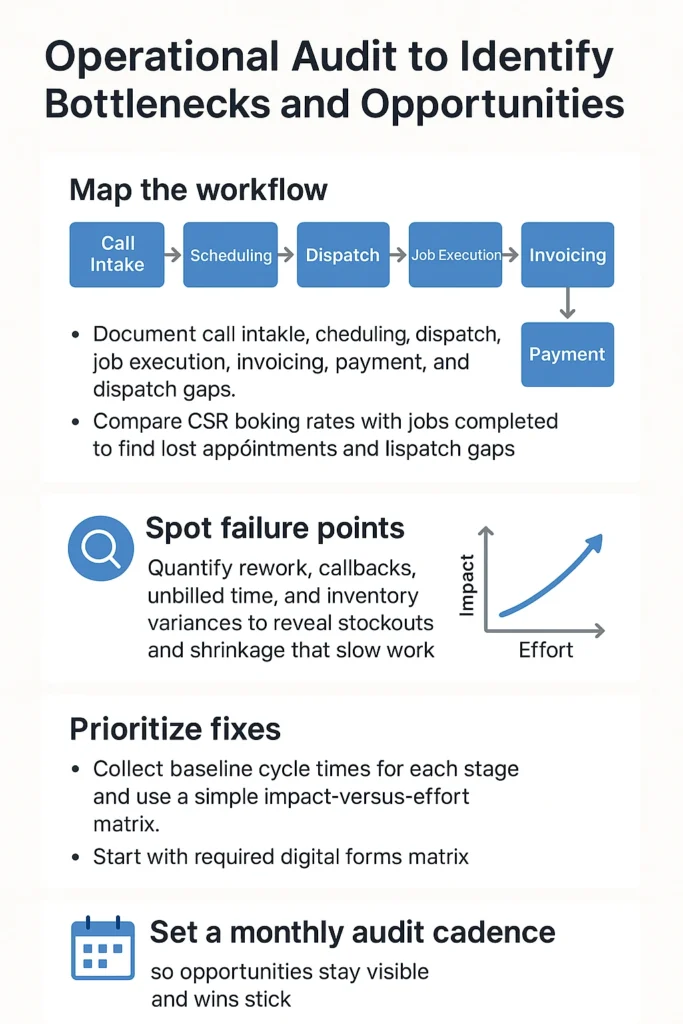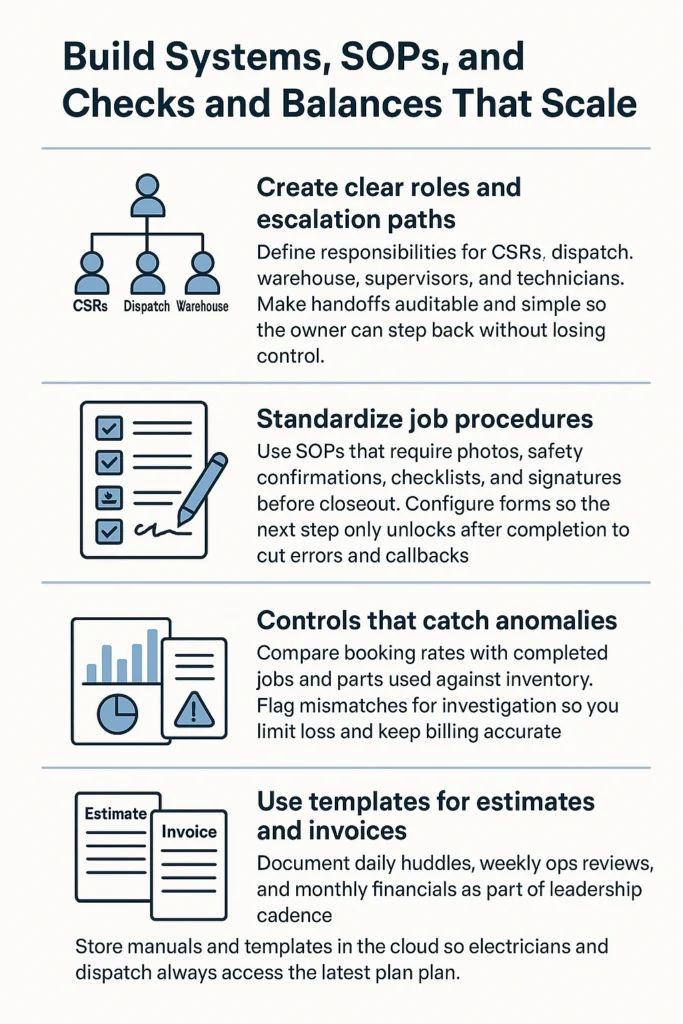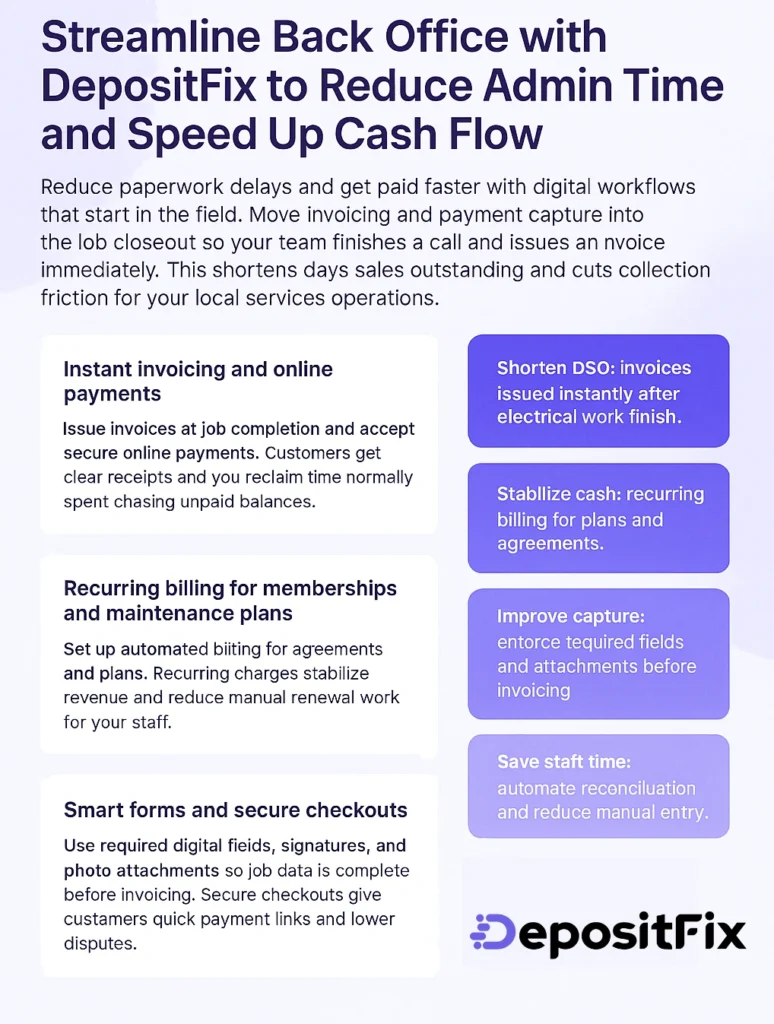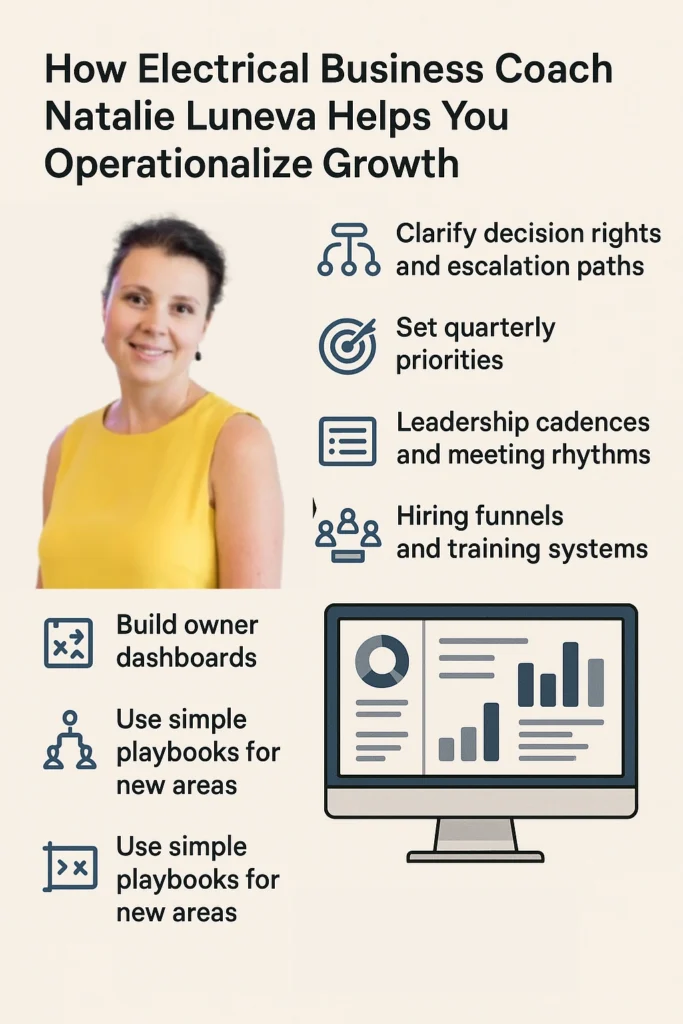You run a service firm and need clear steps that lift profit and cut owner stress. This intro shows what actually moves the needle: roles that match skills, simple processes, and tight field-to-office handoffs.
Leaders like Natalie Luneva coach owners on capacity targets, service mix, and leadership rhythms. Her guidance and DepositFix tools streamline ops, speed invoicing, and free owner time with instant payments and smart forms.
Make an org chart, limit any manager to five direct reports, and build operating manuals. Use cloud docs, gated forms, estimate templates, and KPI dashboards that track average ticket, first-time fix, rework, and parts versus inventory.
Audit your workflow from calls through follow-up to spot rework, missed billing, and inventory gaps. Then apply fixes by impact and effort so you capture quick wins while you set lasting systems.
Key Takeaways
- Set clear roles and simple SOPs to reduce errors and owner dependency.
- Keep manager spans tight, five or fewer direct reports for control.
- Track core KPIs like first-time fix and days sales outstanding.
- Use continuous recruiting, ride-alongs, and performance pay for reliable techs.
- Adopt cloud docs and templates to gate workflow and speed cash flow.
- Leverage expert coaching and DepositFix for capacity clarity and faster revenue.
Operational Audit to Identify Bottlenecks and Opportunities
An operational audit gives you a clear map of where time, parts, and paperwork leak value. Trace each job from first call through final follow-up. That end-to-end view uncovers where customers, technicians, and office staff lose context or approvals.
Map the workflow
Document call intake, scheduling, dispatch, job execution, invoicing, payment, and follow-up. Compare CSR booking rates with jobs completed to find lost appointments and dispatch gaps.
Spot failure points
Quantify rework, callbacks, unbilled time, and inventory variances. Match parts used per job against inventory movement to reveal stockouts and shrinkage that slow work.
Prioritize fixes
Collect baseline cycle times for each stage and use a simple impact-versus-effort matrix. Start with required digital forms that gate steps and cloud documents that let field crews access the latest job notes and invoices.
- Engage technicians and CSRs to validate delays and capture improvement ideas.
- Make invoicing and payment workflows a priority, DepositFix and Natalie Luneva’s coaching fit here for clearer plans and faster cash.
- Set a monthly audit cadence so opportunities stay visible and wins stick.

Build Systems, SOPs, and Checks and Balances That Scale
A tight operating framework turns one-off fixes into repeatable, auditable work your team can own. Start with an org chart that limits each manager to five or fewer direct reports so coaching and quality control stay practical.
Create clear roles and escalation paths
Define responsibilities for CSRs, dispatch, warehouse, supervisors, and technicians. Make handoffs auditable and simple so the owner can step back without losing control.
Standardize job procedures
Use SOPs that require photos, safety confirmations, checklists, and signatures before closeout. Configure forms so the next step only unlocks after completion to cut errors and callbacks.
Controls that catch anomalies
Compare booking rates with completed jobs and parts used against inventory. Flag mismatches for investigation so you limit loss and keep billing accurate.
- Use templates for estimates and invoices to keep pricing and scope consistent.
- Document daily huddles, weekly ops reviews, and monthly financials as part of leadership cadence.
- Store manuals and templates in the cloud so electricians and dispatch always access the latest plan.
DepositFix can link streamlined documentation with faster invoicing, helping capture every billable item and lowering owner dependency as your operation scales.

Recruit Continuously and Train for Consistent Electrical Service Quality
Keep hiring active year-round so your crew stays ready when demand spikes. Make recruiting an operational habit, not an afterthought, and tie every role to a clear scorecard and the org chart you already use.
Always screen with structure: use structured interviews, skill assessments, and role descriptions that mirror your SOPs. Onboard new hires with a 30-60-90 playbook covering safety, documentation standards, customer communication, and job-quality checkpoints.
- Run ride-alongs to calibrate performance and mentor technicians on diagnostics and documentation.
- Provide job-specific checklists and required forms that capture proof-of-work and approvals.
- Align performance pay to quality KPIs like first-time fix, rework, and documentation completeness.
- Train CSRs and dispatch on intake scripts and scheduling rules to set accurate expectations.
Hold weekly skill huddles, track training completion, and use field audits so coaching links to measurable improvements. Use apprenticeships and referrals to build depth, and lean on leadership system design support from Natalie Luneva for scalable hiring and training plans.

Strengthen Company Culture and Accountability to Improve Customer Service
Simple routines and clear ownership keep your team focused on customers and reduce wasted time. Short, consistent habits make quality measurable and repeatable.
Run 10–15 minute daily huddles to align on safety, schedule shifts, and parts needs. Use end-of-day checkouts so supervisors give quick feedback while details are fresh.
- Publish weekly goals tied to first-time fix, completed jobs per day, and DSO.
- Celebrate wins like zero-callback days and perfect documentation to reinforce desired habits.
- Give technicians and office staff one source of truth for job notes, photos, and estimates.
Make accountability visible with simple scoreboards for KPIs the team can influence. Coach CSRs on empathy and accurate expectation setting so downstream work flows smoothly.
Natalie Luneva’s coaching often includes designing meeting cadences, measurable goals, and clear accountability that support service excellence and protect your reputation.
| Action | Cadence | Primary Impact |
| Daily huddle (10–15 min) | Daily | Faster alignment, fewer missed parts |
| End-of-day checkout | Daily | Timely feedback, improved documentation |
| Weekly KPI scoreboard | Weekly | Visible accountability, reduced rework |
| Blameless post-job review | As needed | Continuous improvement, updated SOPs |
Create a Field-to-Office Workflow Your Technicians and CSRs Can Follow
Make a single, reliable interface that keeps field notes, photos, and customer history within reach for every shift. When job data is unified, you cut errors and save time. Teams can see call history, estimates, and attachments from any device, so handoffs stay clean.
Unified job information
Give CSRs and techs one view of notes, estimates, photos, and documents. That single source of truth keeps records consistent and reduces rework.
Dispatch rules and status updates
Define rules by skills, certifications, geography, and parts availability to lift first-time fix rates. Use clear status codes, scheduled, en route, onsite, awaiting parts, complete, so field progress matches office expectations.
- Require standardized proof-of-work (photos, signatures, codes) before a tech advances status.
- Give dispatch live visibility of technician location and schedule gaps to cut late arrivals.
- Send accurate ETAs and status updates to customers so inbound calls drop.
- Archive all customer messages with the job so anyone answers follow-ups correctly.
Analyze schedule adherence and callback trends weekly. Keep workflows simple across job types so new hires perform with minimal supervision. Review a sample of jobs daily to catch breakdowns and update SOPs quickly.
| Metric | Action | Outcome |
| Schedule adherence | Monitor real-time locations | Fewer missed appointments |
| First-time fix | Dispatch by skills & parts | Lower callbacks |
| Inbound customer calls | Automated ETAs & updates | Reduced call volume |
Control Costs and Improve Profit with Real-Time Financial Visibility
Real-time finance visibility lets you spot margin leaks before they drain a month’s revenue. Use simple dashboards that show job-level profit and labor use so small fixes become reliable wins.
Job costing and labor utilization
Implement a job-level P&L that captures material, labor hours, and allocated overhead. This reveals margin by service type and highlights unprofitable work.
Track labor utilization and separate billable and non-billable hours. Reduce windshield time through smarter dispatching and routing.
Owner-level KPIs you should watch
- Average ticket: monitor trends by service and technician for training gaps.
- First-time fix rate: correlate with callback costs and inventory issues.
- DSO: shorten collections with immediate invoicing and online payments.
- Rework: measure costs and target SOP or inventory fixes.
| Report | Cadence | Key Metric | Action |
| Job-level P&L | Per job | Gross margin by service | Adjust pricing, parts stocking |
| Weekly flash | Weekly | Revenue, backlog, gross margin | Reassign crews, order parts |
| Labor utilization | Weekly | Billable % vs. paid hours | Optimize routes, reduce idle time |
| Inventory vs. parts used | Daily/weekly | Shrinkage, stockouts | Set min/max, audit variances |
Set financial guardrails such as approval thresholds, discount rules, and required documentation. Review KPIs weekly with leaders so corrective actions are assigned and closed fast.
Getting Your Core Operations Right Before Expanding
Mastering core operations protects margins and makes expansion predictable. Narrow your service mix and prove consistent results in one area before you pursue new markets or verticals.
Narrow the focus and document success
Identify your highest-margin, most reliable services and lock SOPs, training, and parts lists around them. Run quality audits and track KPIs, first-time fix, DSO, inventory accuracy, until the metrics are steady.
Build a transferable playbook
Create a playbook that covers org structure, leadership cadences, dispatch rules, and job-level dashboards. Include vendor lists and standard stocking kits so a new site can replicate cost and quality.
- Pilot expansion in a nearby area only after you can backfill roles and hold KPIs without owner input.
- Use a stage gate: capacity met, quality sustained, cash conversion healthy, leadership bench ready.
- Train new leaders on the same meeting rhythms and audit practices to protect margins during growth.
| Stage | Must-have proof | Outcome |
| Pilot | Stable KPIs, playbook ready | Predictable ramp |
| Scale | Backfill plan, vendor contracts | Controlled costs |
| Rollout | Leadership bench, weekly reviews | Maintained quality |
Streamline Back Office with DepositFix to Reduce Admin Time and Speed Up Cash Flow
Reduce paperwork delays and get paid faster with digital workflows that start in the field. Move invoicing and payment capture into the job closeout with DepositFix so your team finishes a call and issues an invoice immediately. This shortens days sales outstanding and cuts collection friction for your local services operations.
Instant invoicing and online payments
Issue invoices at job completion and accept secure online payments. Customers get clear receipts and you reclaim time normally spent chasing unpaid balances.
Recurring billing for memberships and maintenance plans
Set up automated billing for agreements and plans. Recurring charges stabilize revenue and reduce manual renewal work for your staff.
Smart forms and secure checkouts
Use required digital fields, signatures, and photo attachments so job data is complete before invoicing. Secure checkouts give customers quick payment links and lower disputes.
Automations and analytics
Automate reconciliation and attach receipts to job records. Track revenue per service line and surface trends in DSO so you can prioritize high-margin services.
- Shorten DSO: invoices issued instantly after electrical work finish.
- Stabilize cash: recurring billing for plans and agreements.
- Improve capture: enforce required fields and attachments before invoicing.
- Save staff time: automate reconciliation and reduce manual entry.

How Electrical Business Coach Natalie Luneva Helps You Operationalize Growth
Natalie Luneva helps owners turn vague targets into a clear, executable growth roadmap. She works with you to set technician capacity goals, refine your core service mix, and prioritize coverage areas so every choice links to revenue and quality.
She builds owner dashboards that track average ticket, first-time fix, DSO, job costing, and rework. Those metrics let you steer by data rather than guesswork.
Leadership cadences and meeting rhythms
Establish weekly ops, financial, and hiring reviews. Short, focused meetings surface issues fast and keep priorities on course.
Hiring funnels and training systems
Map scorecards and structured interviews, assign owners for each stage, and use trial tasks to vet candidates. Then deploy training tracks with checklists and field audits to confirm competence.
- Clarify decision rights and escalation paths so daily choices leave the owner’s plate.
- Set quarterly priorities tied to bottlenecks like dispatch rules, inventory, and documentation.
- Use simple playbooks for opening new areas only after core execution proves consistent.

Stop juggling endless tasks and start growing your electrical business with confidence. Book a call with Natalie today to create a clear, actionable roadmap that aligns your goals with revenue, efficiency, and operational excellence, so every decision drives measurable growth.
Conclusion
When daily routines run well, your crews complete more jobs and your customers notice the difference.
Operational excellence is the foundation of lasting success. Start with an audit, set clear roles, and enforce SOPs with required forms and templates.
Keep recruiting and training active, hold short rituals like daily huddles, and measure owner-level KPIs so you can fix small leaks fast. A coach like Natalie Luneva helps you set capacity targets and meeting rhythms.
DepositFix trims admin work and speeds cash with instant invoicing, online payments, and smart forms. Tight field-to-office workflows, dispatch rules, and real-time costing protect margins.
Document your systems, stay disciplined, and keep improving. That focus gives you the best chance for steady growth and happier customers.
FAQs
How much should I invest in tools and technology for growth?
Budget for essential upgrades that directly impact productivity and safety. This might include diagnostic tools, field service software, CRM systems, or specialized gear for niche services. Start with high-impact investments that improve efficiency or revenue capture.
How can I finance expansion for my electrical business?
Options include small business loans, equipment financing, lines of credit, or reinvesting profits. Prepare a clear business plan with revenue projections and risk assessments to secure funding.
How can I measure long-term growth success beyond revenue?
Track metrics such as customer lifetime value, referral rates, employee retention, safety incidents, and margin stability. Sustainable growth means balancing profitability, customer satisfaction, and team well-being.
How can I track and improve employee productivity in the field?
Use job management software, mobile timesheets, and field checklists. Monitor key metrics like jobs completed, first-time fix rates, and travel time. Regular feedback and performance incentives keep productivity high.
What KPIs should I track to ensure sustainable growth?
Track metrics like first-time fix rate, average ticket, days sales outstanding (DSO), rework costs, labor utilization, and inventory accuracy. These reveal operational efficiency and highlight areas for improvement.
What steps should I take before expanding to a new area?
Verify that core operations are stable, SOPs are documented, KPIs are consistently met, and leadership is ready. Pilot in a nearby market first, monitor results, and adjust processes before a full rollout.


